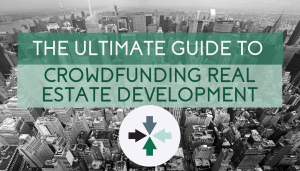How to Syndicate a Real Estate Deal
Real estate syndication is the process by which investors pool their capital resources and expertise to invest in real estate projects that would be too capital-intensive or complicated for an individual investor. This process is nothing new- investors have been combining forces to get real estate projects off the ground since the early days of the property market in the United States.
In recent years, real estate syndication deals have gone mainstream, and are no longer exclusive to the well-moneyed, country club set. The easing of restrictions on general solicitation – the right to advertise – gave rise to real estate crowdfunding and, combined with the spread of digital finance, technology has opened the world of real estate syndication to more investors than ever before.
What is Real Estate Syndication?
A real estate syndication is an investment vehicle in which a group of investors become direct or indirect owners in a one or multiple properties. Often these deals are too expensive or complicated for a single investor, so they join forces to make the deal possible.
Typically, a professional real estate developer, one who spends all his time in real estate development, will finance his projects with two forms of capital; debt and equity.
Debt is most often provided by banks but as banks do not provide 100% of the money to buy and build or renovate a property, real estate developers need to come up with the difference – called the ‘equity.’ Depending on how government banking oversight agencies perceive the need for liquidity in the real estate market, the percentage of the total cost of a project banks will finance will vary. In the period following the global financial meltdown of 2008-09, a developer would most likely,be required to provide 30-35% of the total cost of a project, with the bank only providing 65-70%.
Get access to our FREE weekly newsletter exclusively covering the latest updates from the real estate crowdfunding world
On real estate projects which can be very large in dollar terms, reaching tens or hundreds of millions of dollars or more, there are very few developers who have the wherewithal to provide all the equity capital required by themselves; they must seek outside capital sources to provide the equity they need.
The way they do this is to solicit investment from other private individuals or equity providers.
The resulting group of investors is known as a real estate ‘syndicate’ and hence together they form a real estate syndication.
Real estate syndications are structured by forming a legal entity, a company, often specially formed to handle the development of a single project. These are called Single Purpose Entities or SPE’s, for short. An SPE is formed by the developer that itself owns the real estate being developed or renovated. The developer then sells different classes of shares that come with them certain rights and responsibilities.
These rights and responsibilities include definitions of how shareholders will receive their invested capital back, and how cash-flow and profit from the project with be distributed.
The laws that govern the selling of shares in a company to form a syndicate are securities laws and hence the formation and oversight of real estate syndicates falls under the jurisdiction of the Securities and Exchange Commission; the SEC.
What Kind of Profit Can You Realize in Real Estate Syndication?
There are two primary ways profit is generated in a real estate syndication and they are exactly the same ways as any real estate project generates profits: From rental income and from property appreciation.
Profits from rental income are generated when a building’s operating costs are less than the total income it derives from rents. This cash flow available for distribution to shareholders in the syndicate is called the net operating income (NOI) and is generally paid out pari passu – meaning ‘in proportion to’ – the shareholder’s ownership interest in the entity that owns the real estate.
The other form of profit that is realized in a real estate syndication is that which is generated from the sale of the property.
A developer will only purchase a piece of real estate if they believe that, through either building on it or renovating what currently exists, they can sell it for more than the purchase price plus costs associated with construction or improvement.
Profits from the sale of the building, when compared to profits generated from NOI, typically account for the bulk of the profits a project will provide for investors.
Related: Sponsor Fees and the Motivating Factor in Real Estate Investing
How Do You Get Paid in Real Estate Syndication?
There are various ways involved parties get paid in a real estate syndication, depending on the role you play.
- The Real Estate Developer Role
If you are the developer on a real estate project, (also known as the ‘sponsor’), you will receive various fees in compensation for performing various tasks related to the deal, like locating properties, undertaking due diligence, and creating the structure of the agreement. You will also receive a share of the profits on a project as an incentive for performing to or above projections.
1. Operational Fees
The types of fees a sponsor will receive for managing the syndication will include a raft of services provided. These can include acquisition and disposition fees, property management fees, construction fees, financing and refinancing fees, syndication fees, marketing fees and others. These fees can vary widely, but typically are calculated as a percentage of cost or income generated from rents, though they can also be predetermined flat fees.
2. Assets Under Management (AUM) Fees
The developer can also generate profits from their management of real estate syndications through the collection of ‘assets under management’ fees, which is an ongoing fee paid throughout the lifecycle of a project. This is most often a fee calculated based on the total amount of equity the developer has raised and is managing, though it can also apply to the total value of all real estate that the developer controls.
In most situations, this fee is 1% of total equity or assets under management, is calculated and paid, most often, quarterly, and goes to the developer to cover the overhead of managing the intricacies of the syndicate partnership agreement. This includes facilitating communication between investors, setting goals and deadlines, and taking care of the day to day minutiae of running a property syndication.
For example, if a developer raises $10 million in equity on a project that has a total value of $30 million, they could receive an AUM fee on either of those amounts, depending on the terms that define the syndicate structure.
If the AUM fee is 1% and it is applied only to the equity under management, then in this example, the developer would receive an annual payment of $100,000 per year for managing $10 million of equity. If the fee is 1% of total asset value, then the AUM fee would be $300,000 per year.
Get access to our FREE weekly newsletter exclusively covering the latest updates from the real estate crowdfunding world
3. The Promote
Developers are also compensated with a share of the profits from a deal to incentivize them to perform to or beyond their original projections.
This is calculated based on total profits and is most frequently paid only after investors in the syndicate have received all their invested capital back, plus some percentage – called the ‘preferred return’ (see below).
The promote is calculated as follows: After bank debt is paid off, and syndicate investors have been paid a preferred return plus have received their invested capital back, what remains is the profits from the deal. The promote is that proportion of those profits that goes to the developer before the remainder is split pro-rata to investors depending on their invested amount.
The most common structures based on brand new research across $40bn of assets is that the developer receives between 10-20% of the profits, before investors receive their share.

- The Real Estate Investor Role
Though they do not have any day to day responsibilities in a real estate syndication, investors are compensated for the risk they take providing the equity in a project in two ways; they typically receive a preferred return and a share of the profits.
1. Preferred Return
The preferred return is compensation paid to syndicate investors that is a percentage of the total amount they have invested and either paid current from ongoing cash-flow, or accumulated until the project has enough cash to make the payment. It functions much like interest payments from a bank, though, unlike at a bank, there is no guarantee it will be paid as the project must make money for there to be enough cash to make the preferred return payment.
For example, if the preferred return on a project is 8% and an investor invests $100,000 in the project, they will receive $8,000 per year, usually accumulated and not compounded, until they receive their initial investment back in full.
The most common preferred returns paid are 8%, by 40% of all projects, then 10%, which is paid by 30% of all projects, then 9% and 12% are the next most commonly paid preferred returns.
The outliers range between 2% and 22%, and in some very rare instances, projects pay zero preferred return.
2. Profit Share
Investors are also compensated for participating in the deal with profits and appreciation. A real estate syndication investor’s share of profits is paid in proportion to how much the investor put into the deal.
For Example: If you plan to invest $100,000 in a deal, and are receiving a 10% preferred return, you could potentially make $10,000 each year, as long as the property is generating enough income.
Once every investor receives their preferred return, the remainder is split up between the Sponsor and investors, based on a preexisting profit structure, 80/20, 70/30, etc. In an 80/20 situation, if there are $1 million left in profit after the preferred returns get paid out, the investors would get $800,000, and the Sponsor or Syndicator would get $200,000.
How is Real Estate Syndication Different Than Real Estate Crowdfunding?
As we mentioned earlier, real estate syndication was once the province of the wealthy and connected. Most people were unable to come up with the substantial capital requirements for large projects, and even if they could, they were not dialed into the network of "good old boys" who tended to dominate property development well into the 2000s.
This all changed with a change in regulations brought about by the JOBS Act of 2012, which, for the first time in many generations, permitted developers to advertise the sale of shares in their projects.
Instead of connecting to investors through country clubs, business partnerships, or other traditional methods, real estate developers and newly emerged crowdfunding platforms leveraged the internet as a way to connect with a whole new generation of investors.
For the first time ever, investors can access financial data related to an investment, perform research, and ultimately purchase shares directly with a developer online, rather than going through a cumbersome, often complicated process filled with lunches and small talk.
In many ways real estate crowdfunding and syndication are synonymous- developers can create and fund syndications on crowdfunding sites or by setting up the relevant digital marketing systems themselves. Projects are more accessible to individual investors, have lower minimum capital investments, and more information relating to real estate investment and syndication is now available online than ever before.
Related: The Ultimate Guide to Real Estate Crowdfunding
Step by Step Guide on Syndicating Your First Real Estate Deal
In this section, we will describe, step by step, how to syndicate your first real estate deal.
1. Research, Research, Research
When it comes to investments, the SEC, IRS, and a whole host of other three-letter agencies do not play around. The real estate syndication market is heavily regulated, and numerous rules, regulations, and laws are in place to protect investors and the stability of the market as a whole.
Before undertaking a syndication, you must know these rules like the back of your hand- not paying attention to the pertinent laws could mean disaster for you and your investors.
Always seek the advice of a lawyer when raising money for your projects.
2. Find Investors
The first step to syndicating a deal is finding a group of investors that share your vision, and that are willing to invest in projects that you bring to their attention.
You can find investors in your personal or professional life, through community or business ties, through online crowdfunding platforms, or by creating your own, unique digital marketing systems.
3. Locate Suitable Properties
Once you're up and running, it is time to find properties in which to invest. If you already had a property in mind before/during the investment solicitation process, skip to the next step.
A real estate syndication runs the gamut of property types, from retail centers to office buildings, to suburban and exurban housing developments. You and your investors will have likely come up with an area in which you wish to focus, like for instance, multifamily apartment buildings.
As a syndicator, you would find viable multifamily property purchase opportunities that fit your investment strategy, whether that is to add value to the property and flip, hold for long-term cash flow, or however you and your investors intend to generate a return on their investment.
Get access to our FREE weekly newsletter exclusively covering the latest updates from the real estate crowdfunding world
4. Manage Property Portfolio
Depending on how you plan to generate revenue, and your syndication deal, you may have to oversee the day to day operations at the properties within your portfolio.
Some Sponsors/Syndicators are more hands-off, it just depends on the individual investor desires. Syndicators are typically compensated for their role managing day to day operations.
5. Disburse Funds as Needed
You will be in charge of paying out quarterly or annual payments, as well as additional disbursements when properties are sold. In addition, you will be responsible for the accounting and finances of the deals, and individual properties.
Final Thoughts
Real estate syndication has gone from the boardroom to your living room- or anywhere you have a smartphone with internet access. This monumental shift in how capital is solicited for real estate investments presents a fantastic opportunity for the right real estate Syndicator or Sponsor.
Related: Aspects for Evaluating a Sponsor
If you have only just started in real estate development, have completed no deals, have no email list, but know you want the freedom and wealth being a real estate developer brings, then I suggest your first step is to start evaluating deals so you can recognize a good one when you see it.
Here’s where you should start. You’ll learn everything you need to know – the different types of real estate, different development strategies, how real estate cycles influence the market, and all about due diligence.
If you want to find deals and raise money for them so you can start your real estate development business, then learning how to conduct due diligence so you can pitch your deals better to investors is a great place to start.
If you’ve already purchased one or more real estate project and are seeing more opportunities than you can finance, then now is the time to start building your investor network so you can finance all your next deals quicker.
You’ve already got some momentum; now start finding and educating prospects about what you’re doing so you can build an email list of people to pitch to when you’re ready to raise money for your next deal.
This is what we build for private clients all the time – it’s called the Investor Acquisition System and you can access the entire program right here so you can find prospects, and convert them into being deep pocketed, repeat investors in your deals.
If you are a seasoned pro with multi-cycle experience, a substantial portfolio, a decent deal pipeline, and find yourself spending too much time raising equity capital because you’re still doing it in-person, then it’s time you put technology to work for you.
The wonderful thing about doing this is that you’re not going to be doing anything different than you’re already doing and, guess what, you’ll never have to sit through investor meetings again.
Sounds crazy I know, but I lay the whole thing out for you in this white board workshop where I personally show you exactly what it takes for you to transform your equity raising into a fully automated, capital raising machine so you can find new investors while increasing commitments from your existing network.






